Holly Thompson's Blog, page 29
May 4, 2013
Asian Festival of Children's Content--Glitter from Gathering Books
Later this month I'll be at the Asian Festival of Children's Content (AFCC), to be held May 25-30, at the National Library in Singapore. On May 27, I'll be speaking about editing stories in translation during the AFCC Translation Seminar Reaching Beyond Boundaries Through Translation, and on May 28, at the AFCC Writers and Illustrators Conference I'll be delivering a keynote--Novels Set in Asia: Selling Them Overseas.
This will be my third time at AFCC--here's my post on AFCC 2011, and the SCBWI Tokyo newsletter has included AFCC write-ups from SCBWI Japan attendees and speakers: see Carp Tales spring/summer 2011 and Carp Tales summer 2012. This year AFCC follows the IBBY Congress in Bali and some folks will do IBBY then AFCC. Oh, how I wish I could attend both!
Gathering Books is doing a series of blog posts, Pre-AFCC 2013 Glitter, with some teasers for the conference. I'm featured in this first Pre-AFCC 2013 Glitter post in which I share a bit about my keynote talk and what I've loved about past AFCC conferences.
I look forward to meeting authors, illustrators, agents, editors and readers from around Asia at AFCC 2013. See you there?

This will be my third time at AFCC--here's my post on AFCC 2011, and the SCBWI Tokyo newsletter has included AFCC write-ups from SCBWI Japan attendees and speakers: see Carp Tales spring/summer 2011 and Carp Tales summer 2012. This year AFCC follows the IBBY Congress in Bali and some folks will do IBBY then AFCC. Oh, how I wish I could attend both!
Gathering Books is doing a series of blog posts, Pre-AFCC 2013 Glitter, with some teasers for the conference. I'm featured in this first Pre-AFCC 2013 Glitter post in which I share a bit about my keynote talk and what I've loved about past AFCC conferences.
I look forward to meeting authors, illustrators, agents, editors and readers from around Asia at AFCC 2013. See you there?

Published on May 04, 2013 22:53
April 28, 2013
Goodreads Giveaway of The Language Inside
For those with a U.S. or Canada address, you can enter the Goodreads giveaway for a chance to receive a copy of The Language Inside. Click on the link below.
And for those of you in locations outside the U.S. and Canada, don't despair, there will be a giveaway for you, too.
Good luck!
.goodreadsGiveawayWidget { color: #555; font-family: georgia, serif; font-weight: normal; text-align: left; font-size: 14px; font-style: normal; background: white; } .goodreadsGiveawayWidget img { padding: 0 !important; margin: 0 !important; } .goodreadsGiveawayWidget a { padding: 0 !important; margin: 0; color: #660; text-decoration: none; } .goodreadsGiveawayWidget a:visted { color: #660; text-decoration: none; } .goodreadsGiveawayWidget a:hover { color: #660; text-decoration: underline !important; } .goodreadsGiveawayWidget p { margin: 0 0 .5em !important; padding: 0; } .goodreadsGiveawayWidgetEnterLink { display: block; width: 150px; margin: 10px auto 0 !important; padding: 0px 5px !important; text-align: center; line-height: 1.8em; color: #222; font-size: 14px; font-weight: bold; border: 1px solid #6A6454; border-radius: 5px; font-family:arial,verdana,helvetica,sans-serif; background-image:url(http://www.goodreads.com/images/layou... background-repeat: repeat-x; background-color:#BBB596; outline: 0; white-space: nowrap; } .goodreadsGiveawayWidgetEnterLink:hover { background-image:url(http://www.goodreads.com/images/layou... color: black; text-decoration: none; cursor: pointer; }
And for those of you in locations outside the U.S. and Canada, don't despair, there will be a giveaway for you, too.
Good luck!
.goodreadsGiveawayWidget { color: #555; font-family: georgia, serif; font-weight: normal; text-align: left; font-size: 14px; font-style: normal; background: white; } .goodreadsGiveawayWidget img { padding: 0 !important; margin: 0 !important; } .goodreadsGiveawayWidget a { padding: 0 !important; margin: 0; color: #660; text-decoration: none; } .goodreadsGiveawayWidget a:visted { color: #660; text-decoration: none; } .goodreadsGiveawayWidget a:hover { color: #660; text-decoration: underline !important; } .goodreadsGiveawayWidget p { margin: 0 0 .5em !important; padding: 0; } .goodreadsGiveawayWidgetEnterLink { display: block; width: 150px; margin: 10px auto 0 !important; padding: 0px 5px !important; text-align: center; line-height: 1.8em; color: #222; font-size: 14px; font-weight: bold; border: 1px solid #6A6454; border-radius: 5px; font-family:arial,verdana,helvetica,sans-serif; background-image:url(http://www.goodreads.com/images/layou... background-repeat: repeat-x; background-color:#BBB596; outline: 0; white-space: nowrap; } .goodreadsGiveawayWidgetEnterLink:hover { background-image:url(http://www.goodreads.com/images/layou... color: black; text-decoration: none; cursor: pointer; }
Published on April 28, 2013 17:59
April 26, 2013
From Words and White Space: Building a Verse Novel
April is National Poetry Month in the U.S. and this week I am a guest blogger on Write All the Words, online home of author and poet E. Kristin Anderson. Check out all the previous posts on this site--what a great collection of poetry posts!
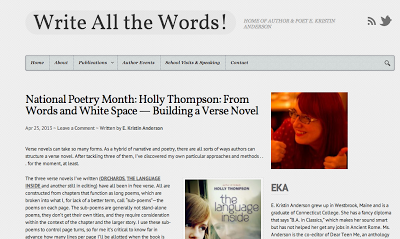
In my guest post, From Words and White Space: Building a Verse Novel, I share thoughts on shaping verse novels and discovering my own particular approach to writing verse novels. Here's the intro:
Verse novels take so many forms. As a hybrid of narrative and poetry, there are so many ways authors can structure a verse novel. After tackling three of them, I’ve discovered my own particular approaches and methods . . . for the moment, at least.
(READ MORE)
Have a look! What are your methods for building a verse novel?

In my guest post, From Words and White Space: Building a Verse Novel, I share thoughts on shaping verse novels and discovering my own particular approach to writing verse novels. Here's the intro:
Verse novels take so many forms. As a hybrid of narrative and poetry, there are so many ways authors can structure a verse novel. After tackling three of them, I’ve discovered my own particular approaches and methods . . . for the moment, at least.
(READ MORE)
Have a look! What are your methods for building a verse novel?
Published on April 26, 2013 17:02
April 25, 2013
Mandarado Yagura Cave Tomb Restoration
I posted on Mandarado previously on this blog, and I'm happy to report that the site of these ancient Kamakura Era cave tombs has been cleaned up, fenced, roped off and better protected. And this year, from April 20 to May 26 on Saturdays, Sundays and holidays, Mandarado is open to the public for viewing from 10 am to 4 p.m.
 on the hike up toward Nagoe Kiridoshi and Mandarado
on the hike up toward Nagoe Kiridoshi and Mandarado
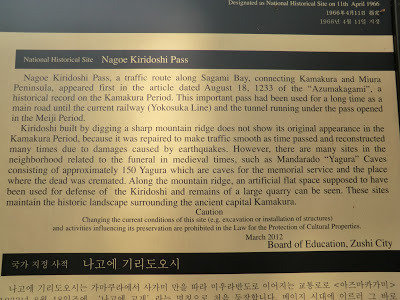 hiking course sign explanation
hiking course sign explanation
 Mandarado
Mandarado
 Mandarado from the lookout point
Mandarado from the lookout point
 hazy view from the lookout point
hazy view from the lookout point
 Mandarado
Mandarado
 Mandarado
Mandarado
Mandarado is on a hilly hiking trail close to Nagoe Kiridoshi, on the Zushi/Kamakura border, one of the main mountain passes that allowed controlled access into the city of Kamakura in medieval times. From Mandarado, you can hike through the hills to the temple Hokokuji. on the hiking course toward Zushi Highlands and Hokokuji
on the hiking course toward Zushi Highlands and Hokokuji
 Zushi Highlands
Zushi Highlands
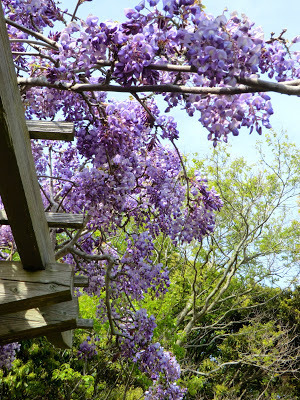 wisteria at Zushi Highlands park
wisteria at Zushi Highlands park
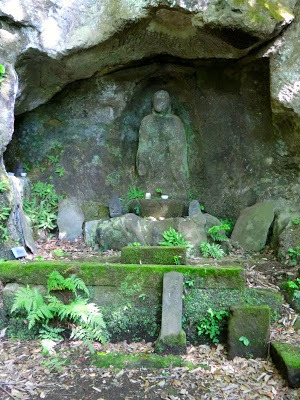 en route to HokokujiSo if you visit Kamakura, consider stepping off the beaten path and try some of the less traveled hiking courses. And if you visit Mandarado, be sure to thank Zushi City staff for taking on this important restoration work.
en route to HokokujiSo if you visit Kamakura, consider stepping off the beaten path and try some of the less traveled hiking courses. And if you visit Mandarado, be sure to thank Zushi City staff for taking on this important restoration work.
 on the hike up toward Nagoe Kiridoshi and Mandarado
on the hike up toward Nagoe Kiridoshi and Mandarado
 hiking course sign explanation
hiking course sign explanation
 Mandarado
Mandarado
 Mandarado from the lookout point
Mandarado from the lookout point
 hazy view from the lookout point
hazy view from the lookout point
 Mandarado
Mandarado
 Mandarado
MandaradoMandarado is on a hilly hiking trail close to Nagoe Kiridoshi, on the Zushi/Kamakura border, one of the main mountain passes that allowed controlled access into the city of Kamakura in medieval times. From Mandarado, you can hike through the hills to the temple Hokokuji.
 on the hiking course toward Zushi Highlands and Hokokuji
on the hiking course toward Zushi Highlands and Hokokuji
 Zushi Highlands
Zushi Highlands
 wisteria at Zushi Highlands park
wisteria at Zushi Highlands park
 en route to HokokujiSo if you visit Kamakura, consider stepping off the beaten path and try some of the less traveled hiking courses. And if you visit Mandarado, be sure to thank Zushi City staff for taking on this important restoration work.
en route to HokokujiSo if you visit Kamakura, consider stepping off the beaten path and try some of the less traveled hiking courses. And if you visit Mandarado, be sure to thank Zushi City staff for taking on this important restoration work.
Published on April 25, 2013 22:27
COETAIL: The Creative Writing Teacher and Fair Use
A post toward obtaining my Certificate in Educational Technology and Information Literacy (COETAIL)
In COETAIL Course 2, we’ll be considering 21st century literacy ideas, questions and issues, and we’re starting by taking a look at fair use, copyright, creative commons, remixes and mashups.
As a creative writing teacher diving into the readings for this second COETAIL course, I find myself thinking about how I encounter issues and questions concerning fair use and copyright in the classroom. I often point my students to the Purdue Online Writing Lab (OWL) for various writing guidance, and there's a helpful OWL page on copyright and fair use.
In creative writing classes, when I assign students to write a short story or poem, I expect them to write an original story or poem. The writing prompts may derive from other works we’ve read in class, or we may borrow a first line or title, or we may even re-use another writer’s basic plot framework or overarching concept, but the resulting work must be a new, original creation.
My students, by and large, do turn in original work, and in part this is due to the fact that in my creative writing classes students write in stages and hand in a final portfolio containing evidence of the process—brainstorming, planning, multiple drafts and final works—so that using a plagiarized story would probably require considerably more effort than originality.
These days, I find myself asking what exactly constitutes an original, new, transformative work in my classroom, and when do my alarm bells go off?
I become suspicious of outright plagiarism in a creative writing class when· a poem has rich layers of meaning that the poet actually doesn’t seem grasp—a brief interview with the student poet usually reveals the poem was copied in full or in part · the plot is just too skillfully constructed... sometimes I discover they have translated a story into English—and sometimes even “borrowed” the translation, too.· the writing is too polished and sounds, er, familiar... one student handed in a chapter of Neil Gaiman’s Coraline word for word. Another handed in the folktale Momotaro with no modifications.
But I find it’s a bit of a gray area when· a story plot reveals action or characterizations that would have required my student to have lived a truly unusual life or to have done years of research... this may indicate that a student has modified a movie summary to create their not-quite-transformed-enough story.· there is a run on a particular story plot in the stories handed in...a bit of sleuthing on my part usually reveals that the basic plot is that of a current or past Japanese TV drama.
Most of my students readily admit to “borrowing” work when confronted with some probing questions from me, and none of my students, when given a second chance to turn in original or more original work, have failed to do so.
Sometimes in teaching creative writing I assign students to borrow a first line from a work, or write found poems, or use the same structure of a published poem or story, or to write in the style of a famous poem or story, or to try retelling a folktale in a fresh new way. I don’t usually ask students to mimic a work outright, though mimicry for artists has long been considered a valid method of training. Writing teacher Rebecca Dierking broached this topic in Creative Copying, or in Defense of Mimicry.
In Nolo’s piece on "The Fair Use Rule," we’re advised, “Never quote more than one or two lines from a poem.” So maybe that rule should be extended for creative writers to, "Never steal more than one or two lines from a poem and always give credit when you borrow." I feel that most important for my students of creative writing who may go the route of borrowing from or changing up others’ works is Rule 1: Is the use of another person’s work just copying or is it creating something new?
As ever more fiction and poetry is available for free online, as plot summaries are everywhere, and as I begin to explore the possibilities in multimedia creative writing projects in which students combine poetry or story with music, images or video, I know my student creative writers will need to be ever more mindful of what and how they borrow. And I as a teacher will need to provide clear guidelines and examples of what’s acceptable and what’s not. I'm looking forward to this COETAIL course!
Published on April 25, 2013 20:36
April 24, 2013
Cambodia Part 2--IKTT and Khmer Silk Weaving
It's been a busy spring with lots of travel, so I'm just now getting around to posting about the second half of my Cambodia trip in February. In the first half of my visit, I was in
Popae Village
. The second half of my stay was spent in the Siem Reap area with five days at the forest village of
IKTT
, brainchild of Kikuo Morimoto. "Project Wisdom from the Forest" is a sustainable eco-artisan village on 23 hectares of land about an hour north of Siem Reap. I was there to learn about ikat weaving in the Khmer tradition, to understand the natural dyeing techniques employed, and to meet the amazing founder.
Kikuo Morimoto was born in Kyoto and trained in yuzen painting and dyeing. He moved to Cambodia via Thailand in the 1980s and has been a key figure in reviving Khmer traditional silk weaving ever since. Morimoto-san speaks his native Japanese, plus Khmer, English, Thai and even some Lao. The forest village, created from scratch, is a communal eco-village with some 150 Cambodian inhabitants on reforested land. The aim was to create a thriving, sustainable community for reviving Khmer silk weaving techniques and producing ikat textiles of the highest quality. Ten years have passed since he put up his first building on the land--a small tree house. And now the village is considered a model community--even Cambodian royalty visit each year for the IKTT silkworm festival.
A few photos from my visit:
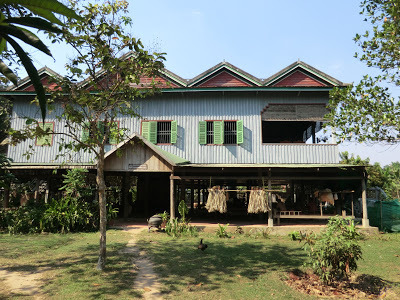 IKTT PWF weaving workshop downstairs, shop upstairs
IKTT PWF weaving workshop downstairs, shop upstairs
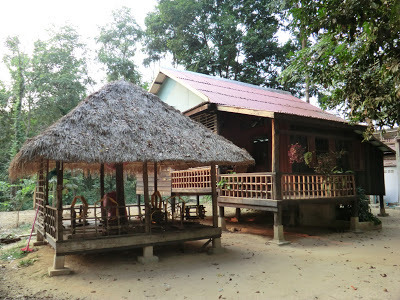 my guest cottage on the right beside a spinning/reeling hut
my guest cottage on the right beside a spinning/reeling hut
 stirring the dye for my natural dyeing experiment with prohut tree bark
stirring the dye for my natural dyeing experiment with prohut tree bark
 my results--some hand spun silk dyed with prohut and an over dye of lime/iron
my results--some hand spun silk dyed with prohut and an over dye of lime/iron
 ikat panel of apsara dancers
ikat panel of apsara dancers
 ikat up close
ikat up close
 sunrise
sunrise
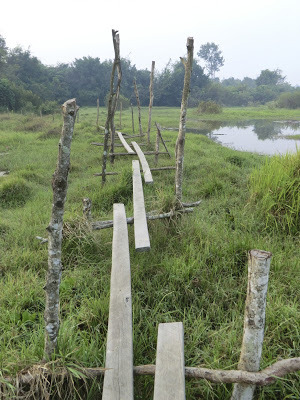 my favorite morning walk
my favorite morning walk
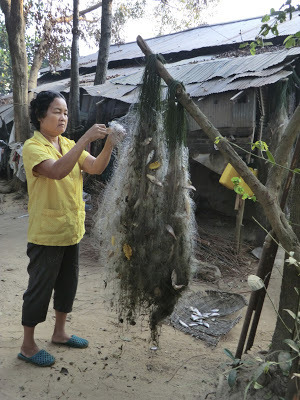 the morning's catch
the morning's catch
 fish for breakfast
fish for breakfast
 Women arriving at the village by bicycle
Women arriving at the village by bicycle
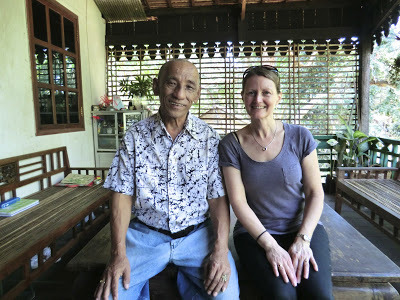 with Kikuo Morimoto
with Kikuo Morimoto
 the IKTT shop in Siem Reap
the IKTT shop in Siem Reap
If you visit Siem Reap, be sure to go to the IKTT shop to see ikat textiles of the highest quality in Cambodia, made from traditional Khmer silk, hand reeled, dyed, and woven. And check out the IKTT blog (in Japanese) for even more photos and IKTT happenings in Japan.
Kikuo Morimoto was born in Kyoto and trained in yuzen painting and dyeing. He moved to Cambodia via Thailand in the 1980s and has been a key figure in reviving Khmer traditional silk weaving ever since. Morimoto-san speaks his native Japanese, plus Khmer, English, Thai and even some Lao. The forest village, created from scratch, is a communal eco-village with some 150 Cambodian inhabitants on reforested land. The aim was to create a thriving, sustainable community for reviving Khmer silk weaving techniques and producing ikat textiles of the highest quality. Ten years have passed since he put up his first building on the land--a small tree house. And now the village is considered a model community--even Cambodian royalty visit each year for the IKTT silkworm festival.
A few photos from my visit:
 IKTT PWF weaving workshop downstairs, shop upstairs
IKTT PWF weaving workshop downstairs, shop upstairs
 my guest cottage on the right beside a spinning/reeling hut
my guest cottage on the right beside a spinning/reeling hut
 stirring the dye for my natural dyeing experiment with prohut tree bark
stirring the dye for my natural dyeing experiment with prohut tree bark
 my results--some hand spun silk dyed with prohut and an over dye of lime/iron
my results--some hand spun silk dyed with prohut and an over dye of lime/iron
 ikat panel of apsara dancers
ikat panel of apsara dancers
 ikat up close
ikat up close
 sunrise
sunrise
 my favorite morning walk
my favorite morning walk
 the morning's catch
the morning's catch
 fish for breakfast
fish for breakfast
 Women arriving at the village by bicycle
Women arriving at the village by bicycle
 with Kikuo Morimoto
with Kikuo Morimoto
 the IKTT shop in Siem Reap
the IKTT shop in Siem ReapIf you visit Siem Reap, be sure to go to the IKTT shop to see ikat textiles of the highest quality in Cambodia, made from traditional Khmer silk, hand reeled, dyed, and woven. And check out the IKTT blog (in Japanese) for even more photos and IKTT happenings in Japan.
Published on April 24, 2013 02:14
April 22, 2013
Earth Day Poem "And Suddenly The Air"
Here is my poem in honor of earth day, drafted a few years ago, just before we moved back to Kamakura. Now, year round I am extra grateful for the clean ocean air in Kamakura (well, except maybe in typhoon season). Happy Earth Day . . . and may we all strive toward cleaner air worldwide.
And Suddenly the Air
is all that mattersthat it be clearand unsullied by fumes or soot
that it carry the scent of soilrotting leavesor recent rain
that it not stingthe eyesnor makethe nose run
that it not givean aftertastebitter on your tongue or in your throat
on waking in a house of latched windowsbuilt too close to the refinery
just after dreamingof sleeping in a housewith windows wide opencurtains billowing on a breeze
© Holly Thompson All Rights Reserved
And Suddenly the Air
is all that mattersthat it be clearand unsullied by fumes or soot
that it carry the scent of soilrotting leavesor recent rain
that it not stingthe eyesnor makethe nose run
that it not givean aftertastebitter on your tongue or in your throat
on waking in a house of latched windowsbuilt too close to the refinery
just after dreamingof sleeping in a housewith windows wide opencurtains billowing on a breeze
© Holly Thompson All Rights Reserved
Published on April 22, 2013 06:00
April 11, 2013
Teaching Creative Writing in a Japanese University
I've been teaching in a public Japanese university since 1999. For most of those years I have taught creative writing, initially integrated into other English classes, but for the past ten years as full-fledged creative writing courses. Recently Rosie Milne interviewed me about teaching creative writing in a Japanese university, and a short version of the interview appears on the new Asian Books Blog. These are the aims of the blog, in Rosie's words:
"I hope Asian Books Blog evolves into an online venue for lively conversation about reading and writing on this continent. I hope it becomes a place where visitors can urge on others' books they've loved--this is generally my own policy when selecting books for the short notices I offer. These notices alternate with posts of a more general nature--interviews, and discussions of relevant topics. Although the blog is in English, in addition to English-language writers, I plan to feature many books in translation, and to talk both to Asian writers who are not writing in English, and also to translators."
So take a peek at the Asian Books Blog and join the conversation.
And here is the longer version of the interview for those who don't mind longer.
************
Asian Books Blog: You’re an American teaching creative writing in Japan. Is language an issue? I assume you teach in Japanese, to Japanese students? How difficult is it to teach creative writing in your second language? If you teach in English to Japanese students, is it difficult to teach creative writing to students writing in their second language?
Holly: I teach a variety of courses, in English, including fiction writing and poetry writing, in a Japanese public university. Most of my students are Japanese; some come from other East or Southeast Asian countries. For all, English is a second language. I love teaching creative writing to students regardless of their English ability, and I believe reading authentic stories and poems in English then striving to write their own helps nonnative speakers connect to and claim the language in a personal way. My students start each semester knowing little about the craft of fiction or poetry, but are quick to learn, and they seem to love the opportunity to be creative with language—something with which they’ve had little or no experience in their previous schooling.
Asian Books Blog: Is there any difference between teaching creative writing in Asia, and in the States?
Holly: Well, of course, anyone writing from within Asia, regardless of their language of writing, will be writing from within their environment in Asia. Climate and culture influence the stories we cultivate. My students also bring into their English writing their thinking from a language completely different in structure from English. Students in Japan have all been well exposed to imagist poets and manga, and many have been in intense educational environments and clubs that meet nearly every day year-round, so they bring to the classroom very different social norms and experiences from those of typical U.S. students. Most of my students in Japan, unlike creative writing students I’ve had in the U.S., have never written a short story in any language, and most have never tried writing poetry. They come into the class with few expectations and much trepidation. It is a joy to watch them morph into ambitious writers and attentive and lively readers.
Asian Books Blog: Are students’ ambitions similar on both continents?
Holly: Few of my students in Japan actually aspire to be writers whereas many students in university creative writing classes in the U.S. do consider creative writing as a viable major and as something that might weave itself into their future. Creative writing is generally not taught in universities in Japan and does not quite fit within the traditional view of university as a stepping stone to a stable job in a Japanese company. But times are changing . . .
Asian Books Blog: Do any issues crop up in class that seem to you specifically Asian?
Holly: Sometimes I encounter students who insist on creating bland characters named Mary and Bob in bland settings in borrowed, predictable plots. I have to convince them that Japan-set stories, and Japanese or other Asian characters, can be convincingly written in English. I have to push them to think of their own unique points of view and find stories from deep within their own bins of collected story seeds. I have to convince them that their Asian-based stories are worth telling to an English-language readership.
Asian Books Blog: Are your students aiming to reach an international, English-speaking readership? Or are they focused on writing for Japan?
Holly: My students are mostly writing for their immediate audience, their fellow university students in Japan, but I encourage them to think more broadly, to think of university students throughout Asia and around the world.
Asian Books Blog: What do you think is the most important aspect of your job as a teacher of creative writing?
Holly: My job is to expose students to possibilities, to share stories and poems that lead to prompts for their own ideas, to give them tools for creating stories and poems in English, and to nurture curious, responsive readers and writers. Most importantly, my aim is to open their minds and to inspire them to discover creativity with words.
Asian Books Blog: What do you find most enjoyable about your job? And the most frustrating?
Holly: Frustrations can usually be worked around—as long as you have students and as long as the institution supports your courses. In an ideal world, my students would all have much more tech support, and would have more creative writing opportunities at the university, but I feel fortunate to have been able to teach creative writing in a Japanese university—it is not a common course offering in Japanese higher education.
I love to see the evolution of the students as they travel from bewildered beginners to imaginative and capable writers. At the end of the semester it’s a joy to hand out the student publications that result, and in the poetry classes to watch students listen with rapt attention as fellow students stand before them reading selected poems from their final portfolios—moving others with their own words.
"I hope Asian Books Blog evolves into an online venue for lively conversation about reading and writing on this continent. I hope it becomes a place where visitors can urge on others' books they've loved--this is generally my own policy when selecting books for the short notices I offer. These notices alternate with posts of a more general nature--interviews, and discussions of relevant topics. Although the blog is in English, in addition to English-language writers, I plan to feature many books in translation, and to talk both to Asian writers who are not writing in English, and also to translators."
So take a peek at the Asian Books Blog and join the conversation.
And here is the longer version of the interview for those who don't mind longer.
************
Asian Books Blog: You’re an American teaching creative writing in Japan. Is language an issue? I assume you teach in Japanese, to Japanese students? How difficult is it to teach creative writing in your second language? If you teach in English to Japanese students, is it difficult to teach creative writing to students writing in their second language?
Holly: I teach a variety of courses, in English, including fiction writing and poetry writing, in a Japanese public university. Most of my students are Japanese; some come from other East or Southeast Asian countries. For all, English is a second language. I love teaching creative writing to students regardless of their English ability, and I believe reading authentic stories and poems in English then striving to write their own helps nonnative speakers connect to and claim the language in a personal way. My students start each semester knowing little about the craft of fiction or poetry, but are quick to learn, and they seem to love the opportunity to be creative with language—something with which they’ve had little or no experience in their previous schooling.
Asian Books Blog: Is there any difference between teaching creative writing in Asia, and in the States?
Holly: Well, of course, anyone writing from within Asia, regardless of their language of writing, will be writing from within their environment in Asia. Climate and culture influence the stories we cultivate. My students also bring into their English writing their thinking from a language completely different in structure from English. Students in Japan have all been well exposed to imagist poets and manga, and many have been in intense educational environments and clubs that meet nearly every day year-round, so they bring to the classroom very different social norms and experiences from those of typical U.S. students. Most of my students in Japan, unlike creative writing students I’ve had in the U.S., have never written a short story in any language, and most have never tried writing poetry. They come into the class with few expectations and much trepidation. It is a joy to watch them morph into ambitious writers and attentive and lively readers.
Asian Books Blog: Are students’ ambitions similar on both continents?
Holly: Few of my students in Japan actually aspire to be writers whereas many students in university creative writing classes in the U.S. do consider creative writing as a viable major and as something that might weave itself into their future. Creative writing is generally not taught in universities in Japan and does not quite fit within the traditional view of university as a stepping stone to a stable job in a Japanese company. But times are changing . . .
Asian Books Blog: Do any issues crop up in class that seem to you specifically Asian?
Holly: Sometimes I encounter students who insist on creating bland characters named Mary and Bob in bland settings in borrowed, predictable plots. I have to convince them that Japan-set stories, and Japanese or other Asian characters, can be convincingly written in English. I have to push them to think of their own unique points of view and find stories from deep within their own bins of collected story seeds. I have to convince them that their Asian-based stories are worth telling to an English-language readership.
Asian Books Blog: Are your students aiming to reach an international, English-speaking readership? Or are they focused on writing for Japan?
Holly: My students are mostly writing for their immediate audience, their fellow university students in Japan, but I encourage them to think more broadly, to think of university students throughout Asia and around the world.
Asian Books Blog: What do you think is the most important aspect of your job as a teacher of creative writing?
Holly: My job is to expose students to possibilities, to share stories and poems that lead to prompts for their own ideas, to give them tools for creating stories and poems in English, and to nurture curious, responsive readers and writers. Most importantly, my aim is to open their minds and to inspire them to discover creativity with words.
Asian Books Blog: What do you find most enjoyable about your job? And the most frustrating?
Holly: Frustrations can usually be worked around—as long as you have students and as long as the institution supports your courses. In an ideal world, my students would all have much more tech support, and would have more creative writing opportunities at the university, but I feel fortunate to have been able to teach creative writing in a Japanese university—it is not a common course offering in Japanese higher education.
I love to see the evolution of the students as they travel from bewildered beginners to imaginative and capable writers. At the end of the semester it’s a joy to hand out the student publications that result, and in the poetry classes to watch students listen with rapt attention as fellow students stand before them reading selected poems from their final portfolios—moving others with their own words.
Published on April 11, 2013 17:44
April 6, 2013
March School Visit Wrap-Up
In March, after the AWP conference in Boston, I visited a number of middle and high schools in Massachusetts. I love doing school visits—talking to young writers, sharing the process from story seeds to published books, starting students on stories and poems, getting questions and comments from my readers, and talking creative writing with teachers.
This wintry trip, I did a number of intensives on writing poetry and narrative verse with students from grades 6 to 12. I also did short story writing with both native and EFL students in 3-day intensives. At a 1-to-1 iPad school, journalism students conducted a press conference asking me question after question after follow-up question. At another school, I was interviewed and filmed by the school TV station. I spoke to students taking a YA literature class—YES, an all YA lit class in high school!—for which Orchards was one of their texts. At another school I spoke to World Literature students who had read Tomo as one of their texts. I talked process with creative writing students; I talked interview methods and feature-writing with nonfiction students. I met with students in an Asian Cultural Awareness group to talk stories and journeys, and on March 11, the two-year anniversary of the Great East Japan Earthquake and Tsunami, I spoke with middle school students about the Tomo; Friendship Through Fiction project and the impact of the disaster on the Tohoku area and all of Japan. I ate lunch in cafeterias and teacher’s rooms and libraries. I met in small groups with ardent young writers, hearing and encouraging their story ideas. I received messages of thanks and hugs, and the breathless, near-tearful confessions of secretly devoted poets and novelists.
 my rental car--on more than one occasion
my rental car--on more than one occasionI even spoke at my own high school alma mater, in the library that had been the gym where I’d practiced basketball and floor hockey, attended concerts and games, and spoke to my fellow graduating seniors about our future meandering paths.
I love doing school visits. They are hard work, requiring hours of preparation, huge reserves of energy, and total focus, but from the questions students ask, I become a stronger writer. I learn from everyone—the students, the teachers and the librarians. Most of all, I love getting young people charged up about words, their impact, their power. I hope that these visits grow more writers and readers, and that along the way I raise a bit of awareness about Japan, Cambodia, other countries of Asia and the many multi-faceted worlds outside the U.S.
Here are a few favorites from the comments I received in Massachusetts:
“Thank you and keep changing the world of literature even more than you already have.” --student“Hearing about what you do now and knowing you grew up similar to the way I have made me feel more hopeful about the things I want to do in the future.” --student "I loved reading Tomo, it was a very inspirational book and really showed me many insights into Japanese culture." --student“I love the poetry that you shared--especially your work. You've inspired all of us, teachers and students alike. You left everyone wanting more. Hopefully we can provide more for our students through more great models and lots of practice.” --teacher“My class was so enthusiastic after your visit and are psyched to read your next book! The students all gave Orchards two thumbs up for me to teach next year.” --teacher
I look forward to my next school visits this spring—next up is Korea!
Published on April 06, 2013 19:57
March 13, 2013
Verse Novel Presentations at the AWP conference
March 6-9 was the annual AWP (Association of Writers and Writing Programs) conference, this year in Boston. I flew in from Japan for this mega event that now draws over 11,000 participants. There were several panel presentations relating to verse novels during the conference, and two of particular relevance to YA writers and readers.
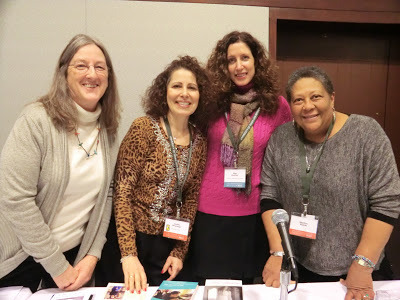 Helen Frost, Lesléa Newman, Meg Kearney, Marilyn NelsonOn Friday, authors Lesléa Newman, Marilyn Nelson, Meg Kearney and Helen Frost (Kwame Alexander was unable to attend) presented on "It Could Always Be Verse: Books in Verse for Young Adult and Middle Grade Readers." While not focused on verse novels per se, in that the works presented were not all fiction, these authors shared the journeys to some of their recent projects in verse--Helen Frost's formal structures in her new historical novel-in-poems Salt set in 1812 Indiana; Lesléa Newman on October Mourning, her collection of poems mourning the death of Matthew Shepard, and on the themed poems in I Remember: Hachiko Speaks; Marilyn Nelson (referred to aptly as a verse historian by one of her readers) on such works as A Wreath for Emmett Till and Carver: A Life in Poems; and Meg Kearney on her novel in poems The Girl in the Mirror. All of these panelists shared their enthusiasm for the use of poetic forms in their work, and noted that the bounds and restrictions of form seem to make the tackling of tough subjects bearable.
Helen Frost, Lesléa Newman, Meg Kearney, Marilyn NelsonOn Friday, authors Lesléa Newman, Marilyn Nelson, Meg Kearney and Helen Frost (Kwame Alexander was unable to attend) presented on "It Could Always Be Verse: Books in Verse for Young Adult and Middle Grade Readers." While not focused on verse novels per se, in that the works presented were not all fiction, these authors shared the journeys to some of their recent projects in verse--Helen Frost's formal structures in her new historical novel-in-poems Salt set in 1812 Indiana; Lesléa Newman on October Mourning, her collection of poems mourning the death of Matthew Shepard, and on the themed poems in I Remember: Hachiko Speaks; Marilyn Nelson (referred to aptly as a verse historian by one of her readers) on such works as A Wreath for Emmett Till and Carver: A Life in Poems; and Meg Kearney on her novel in poems The Girl in the Mirror. All of these panelists shared their enthusiasm for the use of poetic forms in their work, and noted that the bounds and restrictions of form seem to make the tackling of tough subjects bearable.
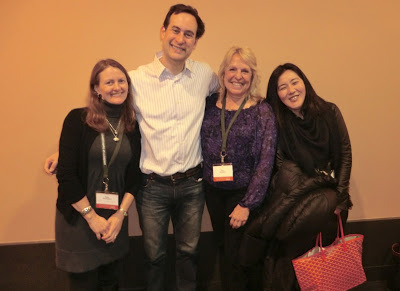 Holly Thompson, David Levithan, Ellen Hopkins, Mariko NagaiOn Saturday, another panel on narrative verse, Poetry Serving Story Serving Teens: Verse Novels for Young Adults, included myself, David Levithan, Ellen Hopkins and Mariko Nagai (Samantha Schutz was unable to attend). In this panel we each read an excerpt from one of our verse novels and discussed reasons for arriving at the particular structure for each book. We shared thoughts on the ease of portraying interior thoughts of characters through verse, and elaborated on the challenges of conveying dialogue and offered up some techniques for making dialogue succeed within verse. We talked about the intriguing fact that verse novels and novels in poems have become such widely accepted and mainstream forms in the young adult lit world, while still remaining fairly obscure in adult literature. While noting that selling foreign rights for verse novels remains a challenge, the panel was upbeat and hopeful that, given the widespread acceptance of verse novels by English-language YA readers, eventually more publishers worldwide will take on narrative verse in translation. And we all concurred that verse novels are best enjoyed in print form for now, since ebook formatting for verse can be problematic, altering the look on the "page" significantly.
Holly Thompson, David Levithan, Ellen Hopkins, Mariko NagaiOn Saturday, another panel on narrative verse, Poetry Serving Story Serving Teens: Verse Novels for Young Adults, included myself, David Levithan, Ellen Hopkins and Mariko Nagai (Samantha Schutz was unable to attend). In this panel we each read an excerpt from one of our verse novels and discussed reasons for arriving at the particular structure for each book. We shared thoughts on the ease of portraying interior thoughts of characters through verse, and elaborated on the challenges of conveying dialogue and offered up some techniques for making dialogue succeed within verse. We talked about the intriguing fact that verse novels and novels in poems have become such widely accepted and mainstream forms in the young adult lit world, while still remaining fairly obscure in adult literature. While noting that selling foreign rights for verse novels remains a challenge, the panel was upbeat and hopeful that, given the widespread acceptance of verse novels by English-language YA readers, eventually more publishers worldwide will take on narrative verse in translation. And we all concurred that verse novels are best enjoyed in print form for now, since ebook formatting for verse can be problematic, altering the look on the "page" significantly.
As for what's in the future for verse narratives for young people, panelists all agreed that this is not a trend, that verse novels are here to stay and that we'll likely be seeing even more experimentation with stories in verse in MG and YA literature in the future. You can certainly expect more stories in verse, both fiction and nonfiction, from each of these eight AWP panelists.
 Helen Frost, Lesléa Newman, Meg Kearney, Marilyn NelsonOn Friday, authors Lesléa Newman, Marilyn Nelson, Meg Kearney and Helen Frost (Kwame Alexander was unable to attend) presented on "It Could Always Be Verse: Books in Verse for Young Adult and Middle Grade Readers." While not focused on verse novels per se, in that the works presented were not all fiction, these authors shared the journeys to some of their recent projects in verse--Helen Frost's formal structures in her new historical novel-in-poems Salt set in 1812 Indiana; Lesléa Newman on October Mourning, her collection of poems mourning the death of Matthew Shepard, and on the themed poems in I Remember: Hachiko Speaks; Marilyn Nelson (referred to aptly as a verse historian by one of her readers) on such works as A Wreath for Emmett Till and Carver: A Life in Poems; and Meg Kearney on her novel in poems The Girl in the Mirror. All of these panelists shared their enthusiasm for the use of poetic forms in their work, and noted that the bounds and restrictions of form seem to make the tackling of tough subjects bearable.
Helen Frost, Lesléa Newman, Meg Kearney, Marilyn NelsonOn Friday, authors Lesléa Newman, Marilyn Nelson, Meg Kearney and Helen Frost (Kwame Alexander was unable to attend) presented on "It Could Always Be Verse: Books in Verse for Young Adult and Middle Grade Readers." While not focused on verse novels per se, in that the works presented were not all fiction, these authors shared the journeys to some of their recent projects in verse--Helen Frost's formal structures in her new historical novel-in-poems Salt set in 1812 Indiana; Lesléa Newman on October Mourning, her collection of poems mourning the death of Matthew Shepard, and on the themed poems in I Remember: Hachiko Speaks; Marilyn Nelson (referred to aptly as a verse historian by one of her readers) on such works as A Wreath for Emmett Till and Carver: A Life in Poems; and Meg Kearney on her novel in poems The Girl in the Mirror. All of these panelists shared their enthusiasm for the use of poetic forms in their work, and noted that the bounds and restrictions of form seem to make the tackling of tough subjects bearable. Holly Thompson, David Levithan, Ellen Hopkins, Mariko NagaiOn Saturday, another panel on narrative verse, Poetry Serving Story Serving Teens: Verse Novels for Young Adults, included myself, David Levithan, Ellen Hopkins and Mariko Nagai (Samantha Schutz was unable to attend). In this panel we each read an excerpt from one of our verse novels and discussed reasons for arriving at the particular structure for each book. We shared thoughts on the ease of portraying interior thoughts of characters through verse, and elaborated on the challenges of conveying dialogue and offered up some techniques for making dialogue succeed within verse. We talked about the intriguing fact that verse novels and novels in poems have become such widely accepted and mainstream forms in the young adult lit world, while still remaining fairly obscure in adult literature. While noting that selling foreign rights for verse novels remains a challenge, the panel was upbeat and hopeful that, given the widespread acceptance of verse novels by English-language YA readers, eventually more publishers worldwide will take on narrative verse in translation. And we all concurred that verse novels are best enjoyed in print form for now, since ebook formatting for verse can be problematic, altering the look on the "page" significantly.
Holly Thompson, David Levithan, Ellen Hopkins, Mariko NagaiOn Saturday, another panel on narrative verse, Poetry Serving Story Serving Teens: Verse Novels for Young Adults, included myself, David Levithan, Ellen Hopkins and Mariko Nagai (Samantha Schutz was unable to attend). In this panel we each read an excerpt from one of our verse novels and discussed reasons for arriving at the particular structure for each book. We shared thoughts on the ease of portraying interior thoughts of characters through verse, and elaborated on the challenges of conveying dialogue and offered up some techniques for making dialogue succeed within verse. We talked about the intriguing fact that verse novels and novels in poems have become such widely accepted and mainstream forms in the young adult lit world, while still remaining fairly obscure in adult literature. While noting that selling foreign rights for verse novels remains a challenge, the panel was upbeat and hopeful that, given the widespread acceptance of verse novels by English-language YA readers, eventually more publishers worldwide will take on narrative verse in translation. And we all concurred that verse novels are best enjoyed in print form for now, since ebook formatting for verse can be problematic, altering the look on the "page" significantly.As for what's in the future for verse narratives for young people, panelists all agreed that this is not a trend, that verse novels are here to stay and that we'll likely be seeing even more experimentation with stories in verse in MG and YA literature in the future. You can certainly expect more stories in verse, both fiction and nonfiction, from each of these eight AWP panelists.
Published on March 13, 2013 09:28



